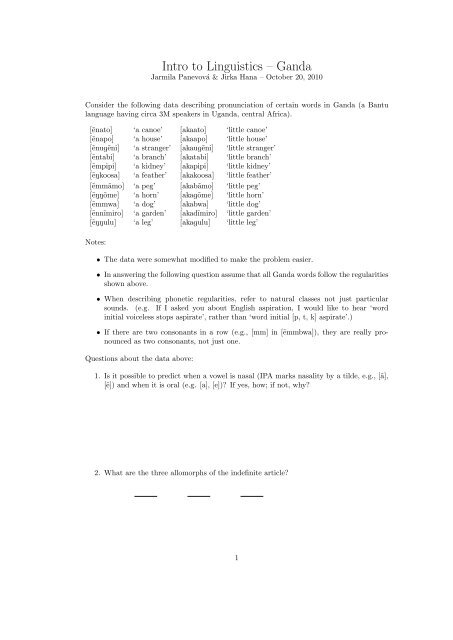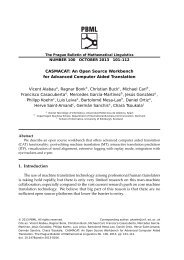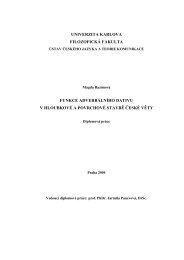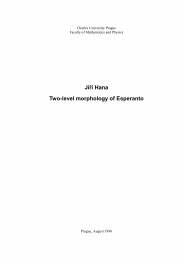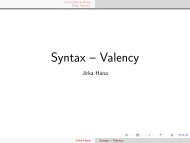Intro to Linguistics – Ganda
Intro to Linguistics – Ganda
Intro to Linguistics – Ganda
You also want an ePaper? Increase the reach of your titles
YUMPU automatically turns print PDFs into web optimized ePapers that Google loves.
<strong>Intro</strong> <strong>to</strong> <strong>Linguistics</strong> <strong>–</strong> <strong>Ganda</strong><br />
Jarmila Panevová & Jirka Hana <strong>–</strong> Oc<strong>to</strong>ber 20, 2010<br />
Consider the following data describing pronunciation of certain words in <strong>Ganda</strong> (a Bantu<br />
language having circa 3M speakers in Uganda, central Africa).<br />
[˜ena<strong>to</strong>] ‘a canoe’ [akaa<strong>to</strong>] ‘little canoe’<br />
[˜enapo] ‘a house’ [akaapo] ‘little house’<br />
[˜enug˜eni] ‘a stranger’ [akaug˜eni] ‘little stranger’<br />
[˜entabi] ‘a branch’ [akatabi] ‘little branch’<br />
[˜empipi] ‘a kidney’ [akapipi] ‘little kidney’<br />
[˜eNkoosa] ‘a feather’ [akakoosa] ‘little feather’<br />
[˜emmãmo] ‘a peg’ [akabãmo] ‘little peg’<br />
[˜eNNõme] ‘a horn’ [akagõme] ‘little horn’<br />
[˜emmwa] ‘a dog’ [akabwa] ‘little dog’<br />
[˜ennĩmiro] ‘a garden’ [akadĩmiro] ‘little garden’<br />
[˜eNNulu] ‘a leg’ [akagulu] ‘little leg’<br />
Notes:<br />
• The data were somewhat modified <strong>to</strong> make the problem easier.<br />
• In answering the following question assume that all <strong>Ganda</strong> words follow the regularities<br />
shown above.<br />
• When describing phonetic regularities, refer <strong>to</strong> natural classes not just particular<br />
sounds. (e.g. If I asked you about English aspiration, I would like <strong>to</strong> hear ‘word<br />
initial voiceless s<strong>to</strong>ps aspirate’, rather than ‘word initial [p, t, k] aspirate’.)<br />
• If there are two consonants in a row (e.g., [mm] in [˜emmbwa]), they are really pronounced<br />
as two consonants, not just one.<br />
Questions about the data above:<br />
1. Is it possible <strong>to</strong> predict when a vowel is nasal (IPA marks nasality by a tilde, e.g., [ã],<br />
[˜e]) and when it is oral (e.g. [a], [e])? If yes, how; if not, why?<br />
2. What are the three allomorphs of the indefinite article?<br />
1
3. State the rule that determines which of the three allomorphs of the indefinite article is<br />
used in which situation. How would you describe the process (e.g., is it assimilation,<br />
deletion, . . . )<br />
4. Sometimes (look at the last 5 examples), the indefinite article affects the pronunciation<br />
of the following consonant (i.e. the first consonant of the stem). When and how? How<br />
would you describe the process (e.g. is it assimilation, deletion, . . . )<br />
5. Fill in the blanks.<br />
‘an animal’ [akaobi] ‘little animal’<br />
‘a bone’ [akagumba] ‘little bone’<br />
2


